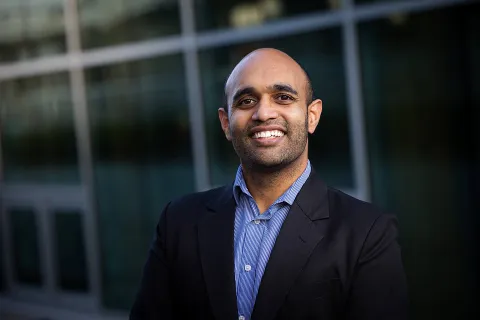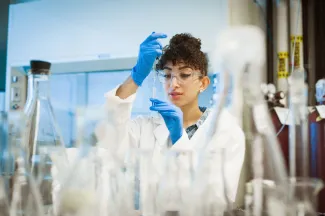With his interdisciplinary research spanning applications from novel processes for manufacturing vaccines to treating toxic mining waste, Dr. Vikram Yadav is proof that “engineering is one of the few disciplines where you can dream things up that don’t exist – and then make them and change the world.”

- Program:
- Campus: Vancouver
Education: BASc (University of Waterloo), PhD (Massachusetts Institute of Technology)
What led you to chemical engineering?
I come from a family of engineers. Both my parents studied chemical engineering: my dad was as a professor and then university president and my mother is an entrepreneur in the pharmaceutical industry. My childhood dinner conversations ranged from the latest industry developments to monetary policy and everything in between. I just loved how my parents approached the world, and how they talked about the process of having an idea, bringing that idea to reality and then being able to positively impact so many lives as a result.
I remember my mother saying to me that engineering is one of the few disciplines where you can dream things up that don’t exist – and then make them and change the world.
Tell us about your research.
I am involved in many different research initiatives, with two significant areas of focus being pandemic preparedness and climate change.
Both of these represent major challenges facing our world, and they are both quintessential chemical engineering problems.
On the vaccine side, I’ve continued my longstanding collaboration with Sanofi that dates back to my undergraduate days. I am working with them to develop processing technologies that will bring down the cost of vaccine manufacturing and reduce vaccine inequity. Vaccine manufacturing requires infrastructure that is not widely available – and that has major implications for public health. My research is looking at how we can build plants in low-resource regions to better serve local populations.
In the climate space, I am developing and commercializing technologies that can be used by industry to achieve sustainability goals. Through my first company, Metabolik, we developed a biotechnology based on an engineered bacterial strain to treat the highly toxic wastewater generated by oil sands operations and that is currently held in tailings ponds. We commercialized this technology and the company was eventually acquired by an American waste remediation venture called Allonnia.
Through my second company, Tersa Earth Innovations, I developed a process for treating mine waste while also recovering valuable metals, like copper and lithium. Tersa recently won the BHP Global Water Challenge – which shows you the quality of the work being done by the many UBC Engineering students involved in my lab. They are the true engines behind the innovation.
What skills do you help students develop?
There are common skills developed across every single engineering lab.
The first is to build technical and research skills – developing specialized analytical abilities, learning how to sift through complex information to identify what is important, and designing experiments. This is a key skill set you will get in any engineering research lab.
But as engineers we aren’t just doing research for the sake of research. I spend a lot of time asking my undergraduate and graduate students to think about the big picture and to identify what the most important problem is that they are trying to solve. Are you saving lives, cutting costs, helping future generations live a better life? Knowing the problem you are solving and the impact you want to have enables you to design your experiment appropriately. This is a process that adds value to both engineering research and to any decision you need to make in life!
Anything else you want to share?
Fundamentally, engineers are optimists. We look at the way things are and are curious about how we can improve them by tweaking what’s there or building something completely new.
There are so many opportunities in engineering if you like collaborating with others to solve challenges.










